原料药技术转移与工艺验证培训课程
- 格式:ppt
- 大小:156.00 KB
- 文档页数:67
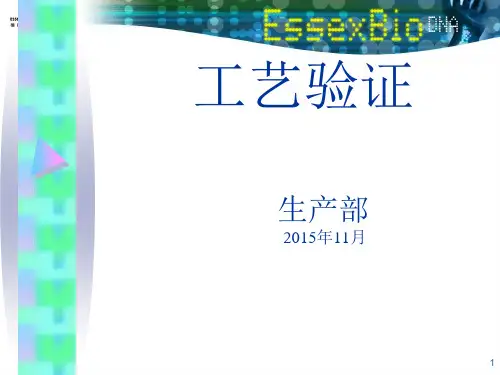
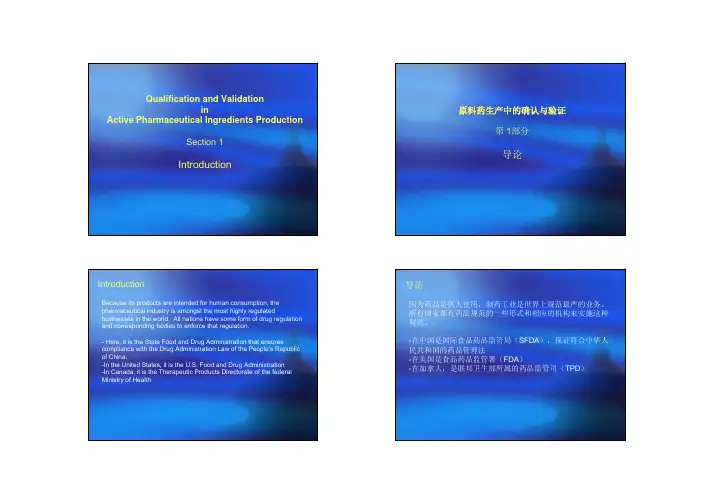

原料药技术转移的差距分析和项目管理技巧目前随着国际间交流的加深以及各大制药公司的并购重组等行为,使制药公司之间的技术转让项目越来越多。
技术转移定义及目标❖技术转移定义制药工业中的技术转移被定义为‘在产品的开发及商业化过程中介于技术/工艺开发者到商业生产中的一整套程序来控制转移相关产品工艺以及相关的书面程序,专有技术的制造过程。
Transfer of technology is defined as “a logical procedure that controls the transfer of any process together with its documentation and professional expertise between development and manufacture or between manufacture sites”. It is a systematic procedure that is followed in order to pass the documented knowledge and experience gained during development and or commercialization to an appropriate, responsible and authorized party.❖技术转移目标技术转移目标通常是:完成工艺性能确认以证明生产的重复性证明接收方最后所生产出来的产品是相似的获得生产和销售方面技术转移的批文通过足够多的批次,包括加工、产品、操作、和检测,证明生产的耐受性。
符合过程中间产物和成品质量标准,工艺标准(如,pH和温度),期望收率,法规和质量要求,以及环境、健康和安全要求。
技术转移的实施内容在药品整个的生命周期中,即从开发,工艺放大,产品申报, 上市,商业化供应及其他阶段中都可能涉及到TOT(Transfer of Technology), 转移可能包含以下的类型及内容:a) Transfer of development and production (processing, packaging and cleaning);b) Transfer of analytical methods for quality assurance and quality control;c) Skills assessment and training;d) Organization and management of the transfer;e) Assessment of premises and equipment;f) Documentation and Qualification and Validation.技术转移成功关键技术转移中,转移的最大的工作量在分析方法的转移和重现中,所以一般分析方法的转移应在工艺转移之前进行并完成;技术转移中,建议在正式转移至拟进行商业化生产的设备场地之前先进行小批量产品的转移(Pilot Scale)进行产品的分析及工艺的重现;需要进行生产重现的Pilot Scale 的具体批量,批数量以及拟用设备等可根据同接受场地商业化生产设备的差距分析的相关内容综合制定方案;技术转移中所有双方交换的信息都应被适当,完整有效的记录,转移正式实施前双方应签署建立有相关的商业合作协议以及涉及质量的质量协议等相关协议,相关的方案及技术文件应由双方相应人员参与评估并建立;技术转移中,在技术转移的方案的制定的过程中应考虑设定适当批次的工程批次,降低相应的风险。
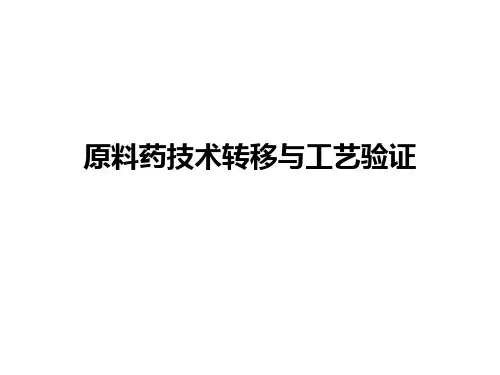
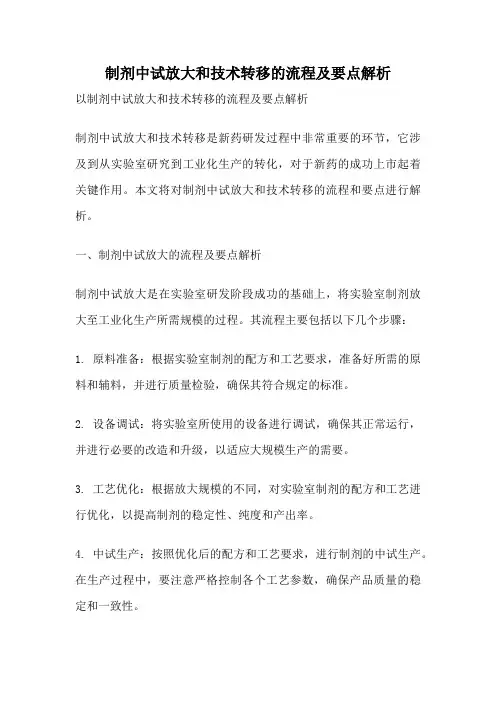
制剂中试放大和技术转移的流程及要点解析以制剂中试放大和技术转移的流程及要点解析制剂中试放大和技术转移是新药研发过程中非常重要的环节,它涉及到从实验室研究到工业化生产的转化,对于新药的成功上市起着关键作用。
本文将对制剂中试放大和技术转移的流程和要点进行解析。
一、制剂中试放大的流程及要点解析制剂中试放大是在实验室研发阶段成功的基础上,将实验室制剂放大至工业化生产所需规模的过程。
其流程主要包括以下几个步骤:1. 原料准备:根据实验室制剂的配方和工艺要求,准备好所需的原料和辅料,并进行质量检验,确保其符合规定的标准。
2. 设备调试:将实验室所使用的设备进行调试,确保其正常运行,并进行必要的改造和升级,以适应大规模生产的需要。
3. 工艺优化:根据放大规模的不同,对实验室制剂的配方和工艺进行优化,以提高制剂的稳定性、纯度和产出率。
4. 中试生产:按照优化后的配方和工艺要求,进行制剂的中试生产。
在生产过程中,要注意严格控制各个工艺参数,确保产品质量的稳定和一致性。
5. 产品评价:对中试生产的产品进行全面的评价,包括物理性质、化学性质、生物性质等方面的测试和分析,以确保产品符合规定的质量要求。
6. 技术总结:对中试生产的工艺过程进行总结和归纳,分析其中的问题和不足,并提出改进措施,为后续的技术转移做好准备。
制剂中试放大的要点主要包括以下几个方面:1. 严格控制质量:在制剂中试放大过程中,要严格控制原料的质量,确保其符合规定的标准。
同时,要加强对中试生产过程中各个环节的质量控制,确保产品的稳定性和一致性。
2. 工艺优化:通过对实验室制剂的工艺进行优化,可以提高产品的稳定性、纯度和产出率,减少生产成本,提高经济效益。
3. 设备升级:根据放大规模的不同,对实验室使用的设备进行必要的改造和升级,以适应大规模生产的需要。
4. 产品评价:对中试生产的产品进行全面的评价,包括物理性质、化学性质、生物性质等方面的测试和分析,以确保产品的质量符合规定要求。
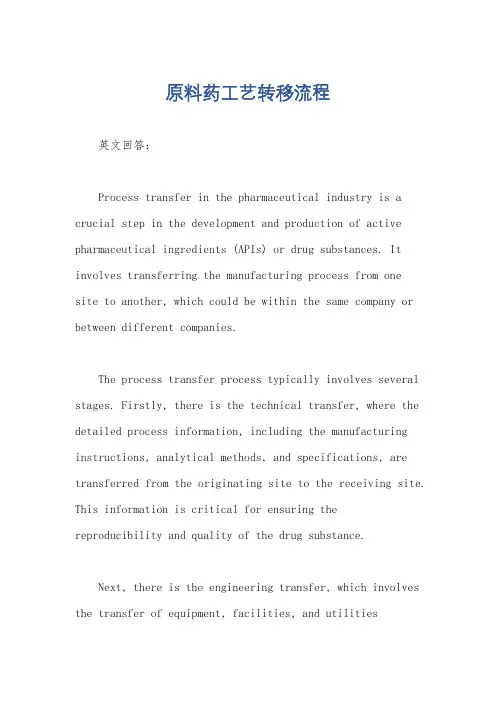
原料药工艺转移流程英文回答:Process transfer in the pharmaceutical industry is a crucial step in the development and production of active pharmaceutical ingredients (APIs) or drug substances. It involves transferring the manufacturing process from onesite to another, which could be within the same company or between different companies.The process transfer process typically involves several stages. Firstly, there is the technical transfer, where the detailed process information, including the manufacturing instructions, analytical methods, and specifications, are transferred from the originating site to the receiving site. This information is critical for ensuring thereproducibility and quality of the drug substance.Next, there is the engineering transfer, which involves the transfer of equipment, facilities, and utilitiesrequired for the manufacturing process. This could include the transfer of reactors, purification systems, and other equipment necessary for the production of the API.Once the technical and engineering transfers are complete, there is the process validation stage. This involves conducting a series of experiments and tests to demonstrate that the transferred process can consistently produce a drug substance that meets the required quality standards. This is an important step in ensuring the safety and efficacy of the drug.During the process transfer, it is essential to consider various factors that could impact the process. These factors include differences in equipment, raw materials, operating conditions, and environmental factors. For example, if the receiving site has different equipment than the originating site, adjustments may need to be made to the process to ensure compatibility. Similarly, if the raw materials used at the receiving site are different, their impact on the process needs to be evaluated.Additionally, it is important to consider any regulatory requirements that may differ between the originating and receiving sites. This could include differences in regulatory guidelines, documentation requirements, or even differences in the interpretation of the guidelines. It is crucial to ensure compliance with all applicable regulations to avoid any regulatory issues.Overall, the process transfer in the pharmaceutical industry is a complex and critical process that requires careful planning, coordination, and attention to detail. It is essential to ensure that the transferred process can consistently produce a drug substance of the required quality, while also meeting all regulatory requirements.中文回答:药品行业中的工艺转移是药物原料(API)或药物成分的开发和生产过程中的关键步骤。



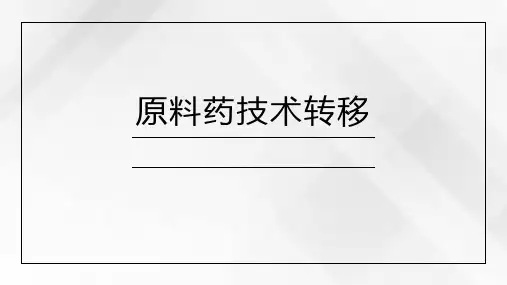
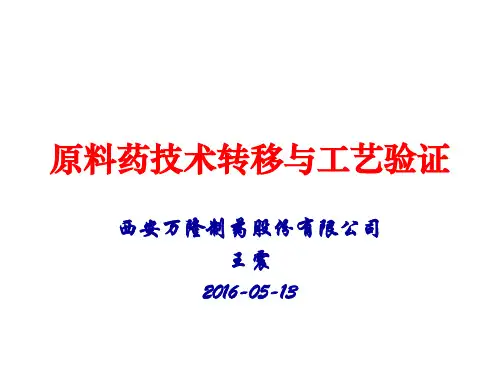
工艺验证系列:第一节--工艺验证概述及传统工艺验证工艺验证的定义工艺验证应当证实一个生产工艺根据规定的工艺参数能够持续生产出符合预定用途和注册要求的产品.工艺验证可以有不同的验证方法,一般包括:传统工艺验证〔前验证、同步验证〕以及基于生命周期的工艺验证〔工艺设计、工艺确认、持续工艺确认〕.工艺验证不应该是一次性的事情.鼓励药品生产企业采用新的工艺验证方法,即基于生命周期的方法,将工艺研发、商业生产工艺验证、常规商业化生产中持续工艺确认相结合,来确定工艺始终如一的处于受控状态.工艺验证的一般原那么工艺验证的方法和方针应该有文件记录,例如,在验证总方案中规定.采用新的生产处方或生产工艺进行的首次工艺验证应当涵盖该产品的所有规格.企业可根据风险评估的结果采用简略的方式进行后续的工艺验证,如选取有代表性的产品规格或包装规格、最差工艺条件进行验证,或适当减少验证批次.工艺验证批的批量应当与预定的商业批的批量一致.企业应当根据质量风险治理原那么确定工艺验证批次数和取样方案,以获得充分的数据来评价工艺和产品质量.企业通常应当至少进行连续三批成功的工艺验证.对产品生命周期中后续商业生产批次获得的信息和数据,进行持续的工艺确认.企业应当有书面文件确定产品的关键质量属性、关键工艺参数、常规生产和工艺限制中的关键工艺参数范围,并根据对产品和工艺知识的理解进行更新.可能与性能确认同步开展.用于工艺验证的分析方法已经过验证.风险.日常生产操作人员及工艺验证人员应当经过适当的培训.工艺验证在执行前应进行适当的风险评估,以确定存在的风险点.如企业从生产经验和历史数据中已获得充分的产品和工艺知识并有深刻理解,工艺变更后或持续工艺确认等验证方式,经风险评估后可进行适当的调整.对于既有产品生产现场转移,生产工艺与限制必须符合上市授权,并符合当前对该产品类型的许可标准.如果需要的话,应提交上市授权变更.对从一个场所转移到另外一个场所或者在相同场所的产品工艺验证,验证批的数目可以通过括号法减少.然而,现有的产品知识,包括以前的工艺验证内容,应该是适宜的. 如果合理,不同的规格、批量和包装量/容器类型的工艺验证的选择也可以使用括号法. 传统工艺验证传统工艺验证的类型一般包括前瞻性验证、同步性验证.前验证一般在药物研发和/或工艺研发结束后,在放大至生产规模后,成品上市前进行.前瞻性验证是正式商业化生产的质量活动,是在新产品、新处方、新工艺、新设备正式投入生产使用前,必须完成并到达设定要求的验证.在对患者利益有很大的风险的例外情况,也可以在常规生产中进行工艺验证,即同步验证,例如,因药物短缺可能增加患者健康风险、因产品的市场需求量极小而无法连续进行验证批次的生产.然而,实施同步验证的决定必须进行论证,在验证总方案中进行记录, 并由授权人员批准.因同步验证批次产品的工艺和质量评价尚未全部完成产品即已上市, 企业应当增加对验证批次产品的监控.传统工艺验证方法,是在日常条件下生产假设干批次的成品来确认其重现性.应编写书面的工艺验证方案,并根据工艺验证方案来证实工艺的重现性及符合性,一般情况下,在日常生产条件下至少连续生产3批形成一个验证程序是可以被接受的.也可通过考量是否使用了标准方法生产,及类似产品或工艺是否已经在现场使用过,来解释证实可选择其他的批次数.三个批次的初始验证实践可能需要后续批次中获得数据类来补充,这些后续批次将作为一个持续工艺确证活动的一局部.工艺验证方案工艺验证方案中至少要包含但不限于以下要素:目的及范围;责任;•参考文件及相关法规;•产品和工艺描述〔包括批量等〕及相关的主批记录;•关键质量属性的概述及其接受限度;•关键工艺参数的概述及其范围;•应当进行验证的其他质量属性和工艺参数的概述;•建议的中间工艺限制参数范围与验收标准.•成品放行的质量标准;拟进行的额外试验,以及测试工程的可接受标准,和已验证的用于测试的分析方法;验证前检查确认,包括:设备设施/公用系统验证及监控状态、分析方法验证状态、检测仪器验证状态、物料检查确认、人员培训、仪器仪表校准情况等;取样方法、方案及评估标准;工艺验证执行策略/方法;待执行的附加测试,与接受标准.结果记录与评估方法〔包括偏差处理〕;建议的时间进度表工艺验证实施工艺验证实施必须有经过培训的人员进行,并根据规定的验证时间方案进行.工艺验证期间,车间人员的一切行为均应根据相关的治理、操作SOP进行.操作人员按生产工艺规程规定进行操作,生产工艺规程要对所要求的工作进行充分描述.在工艺验证过程中,将对所列出的关键工艺参数进行检查确认.根据工艺过程及产品质量标准确定的取样方案,合理安排人员进行生产产品的取样并进行检测.生产工艺结束后,应按文件规定对产品进行成品检验,检验结果应符合成品质量标准, 将统计结果记入测试数据表中.根据验证检验结果,对工艺验证结果的各步骤进行分析、总结.工艺验证报告证实工艺验证方案提供的记录表中所有的测试工程都已完成并已附在总结报告上;证明所有变更和偏差已得到记录和批准并附在报告上,并提交批准.报告内容至少包括:•批记录及批检验数据,包括失败测试的数据.•对方案的结果进行记录以及评估,并形成分析报告.•对整个工艺验证进行总结评价,评价结果记录到验证报告中.通过数据分析指出现有工艺规程或限制中需要适当修订和改变的地方,使工艺规程更加完善,工艺过程更加稳定.如果所得结果显示已显着偏离预期,那么需要立即通知药监当局.这种情况下,要拟定纠正举措,所有拟定的生产工艺变更均应通过变更途径经过适当的法规批准.基于所获得的数据,应给出结论和建议,说明验证时的监控和中间限制是否都需要在日常生产中常规执行.工艺验证系列:第二节--基于生命周期的工艺验证之工艺设计阶段基于生命周期的工艺验证基于生命周期的工艺验证方法,将工艺研发/设计、商业生产工艺验证、常规商业化生产中限制状态的工艺维护相结合,来确定工艺始终如一的处于受控状态.第一阶段--工艺设计:在开发和放大活动过程中获得的知识根底上,对商品化制造工艺进行定义.第二阶段--工艺确认:在此阶段,对工艺设计进行评估,以确认工艺是否具备可重现的商品化制造水平.第三阶段--持续工艺确认:在日常生产中获得工艺处于受控状态的持续和不断开展的保证.基于生命周期的工艺验证活动过程,如图:工艺设计〔第一阶段〕工艺设计是界定商业化制造工艺的活动,目的是设计适合可以始终如一地生产出符合其质量属性产品的日常商业化制造工艺.在此阶段将建立和捕获工艺知识与理解,确立生产工艺并建立工艺限制策略.开发过程中可以集中使用风险评估与治理.从产品研发活动中获得的工艺信息可在工艺设计阶段应用.商品化制造设备的设计功能和局限应在工艺设计中予以考虑,不同组成批、生产操作人员、环境条件、和测量系统等可能具有的对变异的预期作用也应予以考虑.设计具备有效的工艺限制方法的高效工艺,有赖于获得的工艺知识和理解.实验设计〔Design of Experiment, DOE〕研究,即通过揭示关系,包括多种变异输入的多远相互作用〔如,组份个性或工艺参数〕以及输出结果〔如,中间产物、成品〕,有助于开发工艺知识.风险分析工具可用于甄选实验设计研究的潜在变异以最大限度地减少开展的试验总数,同时使获得的知识最大化.实验设计研究的结果能为组份质量、设备参数及中间产物质量属性的范围的建立提供理由和依据.通常,早期工艺设计不需要在cGMP条件下进行,但是,早期的工艺设计实验应依照可靠的科学方法和原那么进行,包括良好的文件治理标准.第一阶段可交付的成果主要有:质量目标产品档案〔QTPP〕药品研发的目标是设计一个高质量产品,其生产工艺能始终如一的交付符合其预定性能的产品.第一阶段初始就应规定质量目标产品档案,便于整个产品生命周期参考使用. 质量目标产品档案收录药品相关的所有质量属性,定期更新,以整合在药品研发过程中可能生产的新数据,但不应偏离药品目标产品档案已确立的核心目标.质量目标产品档案总结了保证产品平安性与有效性的质量属性.它提供了一个评估产品质量属性关键性的起始占八、、QTPP涉及的相关特征包括:临床预定用途〔如,剂型与剂量、给药途径、释放系统〕;适合于即将开发的药品剂型的药用物质质量属性〔如,物理、化学与生物属性〕;适用于预期上市产品的药品质量属性〔如,纯度/杂质、稳定性、无菌、物理和化学性质〕;治疗局部的释放或转递,以及影响药代动力学特征的属性〔如,溶出度〕;影响工艺水平、稳定性或药品生物效应的辅料与成分质量属性、药物-辅料相容性,以及药物-容器相容性关键质量属性〔CQA〕关键质量属性是一个物理、化学、生物学或微生物学性质或特性,应具备适当的限度、范围或分布,以保证目标产品质量.在工艺开发的早期,可用的产品属性信息有限,因此,首套的关键质量属性可能来自早期开发和/或类似产品获取的先前知识而不是大量的产品特征.质量属性的关键程度从所用的风险评估工具及属性对平安性和有效性的潜在影响中得出,如下列图图2产品属性关键性评估矩阵举例注:严重性水平基于对患者的潜在影响,不确定性水平那么基于用于确定属性潜在严重性水平的可获取信息量〔产品知识及临床试验〕的多少.潜在关键质量属性的辨识将从产品开发早期持续进行.根据产品及其应用的一般知识和有效的临床与非临床数据,对局部评估结果将进行进一步的研究评估,以减少较高风险属性的不确定性的数量.在第二阶段活动开始之前应最终确定商业化产品的关键质量属性. 明确生产工艺生产工艺旨在始终如一的提供满足其质量属性需求的产品.研发过程中,随着工艺的明确,工艺将被描述并作为一种工具来辅助风险评估的实施和限制策略的研发.生产工艺可以用工艺描述、方块图、或工艺流程图对各操作单元进行描述,描述应包含如下信息:♦工艺要求,包括原料、规模和操作顺序♦设立工艺参数点与范围♦物流〔添加物、废物、产品流〕的辨识与定量♦检验、取样、过程中间限制♦产品与其他添加溶液的保存时间与保存条件♦估算步骤产量与时间♦设备尺寸,含色谱柱与过滤单元♦生产〔如,过滤器〕与产品组件〔如,瓶、胶塞〕的专门鉴别〔制造商、部件编号〕♦其他成功再现工艺所需的信息工艺的各种描述应以报告的形式记录, 并可作为产品的技术转移包的一局部. 第一阶段中,物料需求的增加〔如,工艺与分析的开展、临床需要〕可引起工艺变更;对产品理解的提升可导致关键质量属性变更;对工艺理解的提升可引起操作单元增加、消除或调整. 应记录这些变更及其支撑理由,并在知识治理体系中存档.研发报告中的商业化生产工艺研发与文件应先于正式的工艺特征研究.在工艺特征中获得的知识可能引起工艺描述的增加变更.所有的工艺变更都应经质量表达中的变更限制规程审批.分析方法原料、中间体、药用物质及药品的分析是限制策略与工艺特征研究的重要组成局部.研究所用的分析方法应适合其预定用途,科学、可靠且可再现.研发过程中所使用的分析方法应在第一阶段进行确认/验证,并为此阶段的生命周期评价测试提供检验方法.工艺特征研究过程中使用的分析方法的信息应包含在工艺特征方案中,并在研究报告中记录.风险评估与参数关键性确定商业化限制策略研发中,理解工艺参数变化的影响性和适当限制的应用是根底要素. 在工艺特征研究之前,基于先验知识和早期开发工作,初始评估并辨识出工艺过程中对产品质量或工艺性能产生最大影响的输入参数,为后续的工艺特征研究奠定根底.在后续的工艺特征研究中,随着研究的深入,应基于关键性和风险分析确定关键工艺参数.在第一阶段应以文件形式明确定义并清楚理解参数制定,且其定义在整个验证周期内应保持一致.参数可基于对产品质量和工艺性能的影响来评估定义.基于对产品质量的影响可将工艺参数评估为:关键工艺参数:此工艺参数发生改变后可影响某项关键质量属性〔ICH Q8〕.关键工艺参数在一个较窄的可变范围内进行维护.非关键工艺参数:工艺参数在较大范围内变动不影响产品质量.基于对工艺性能的影响可将非关键工艺参数进一步评估为:重要工艺参数:在规定的范围外运行,对工艺性能或一致性具有影响.非重要工艺参数:在一个宽泛的范围内,对工艺性能或一致性影响很小.图3提供了参数评估的决策树:图3参数评估决策树工艺特征工艺特征是一系列的研究文件记录,在这些研究中将操作参数进行有目的地改变,以确定其对产品质量属性与工艺性能的影响.此方法运用风险评估的知识与信息来确定一套工艺特征研究,以检验工艺参数的拟定范围及相互作用,其结果信息用于定义工艺性能确认的范围与可接受标准,以及设置最后的参数范围.工艺特征通常要经过实验室小试模型、中试模型的研究.对于这些小规模的研究,应比拟原料、成分属性、设备和工艺参数,并可说明商业化生产的工艺预期.当实际性能与预期性能存在差异时,应当适当修改实验室模型和模型预测.产品特征检验方案除了放行标准外,第一阶段的可交付成果还应包括为了产品与工艺进行综合理解而对药用物质、药品,或关键中间体进行的其他测试.工艺限制策略建立有效并适当的工艺限制策略是第一阶段药品开发的重要成果之一.适当的限制策略以第一阶段获得的知识和经验为根底,其有效性将指示生产工艺仍然处于受控状态.有效限制策略的开发是一个重复过程,其始于开发早期,随着工艺与产品知识的增加而进化.所有产品质量属性和工艺参数,无论其是否被归为关键,均归为全面工艺限制战略中, 包括一下要素:♦原料限制♦放行标准♦过程中间限制与限度♦工艺参数设置点与范围♦日常监测要求〔包括过程中间限制的取样与检验〕♦中间体、工艺溶液的储存与实践限度,及工艺步骤♦设计空间〔如适用〕♦工艺过程分析技术〔PAT〕的应用与算法〔如使用PAT〕临床生产经验-批记录与生产记录第一阶段,用临床试验批来支持产品的审批.这些数据可与工艺特征数据一起,用于支持生产工艺参数和工艺限制策略的建立.数据还包括从开始到工艺性能确认后的工艺监控.早期批次数据不可能包含所有最终商业中执行的限制,但信息对评价工艺性能仍有价值.如果用于支持范围与限度,临床批次数据也应包含于最终的工艺设计报告中,用以调整工艺和限制策略.第一阶段结束时应生成最终批记录,并作为第二阶段的前奏.工艺设计报告报告工艺设计报告也是第一阶段的输出结果.作为一个详细描述预期商业化工艺的活文件, 其在内部规程方面可有各种不同名称.可用第一阶段的研究数据来支持这个文件,并证实范围和工艺限制策略.其他数据和工艺知识可从生产工艺变更中所获得,并纳入第二阶段与第三阶段.工艺设计报告文件应注意信息的更新.工艺设计报告一般包括:•对关键质量属性的参考及风险评估的支撑资料•工艺流程图•流程描述表-输入〔中控〕、输出〔过程中间测试与限度,过程中间标准〕•工艺参数与范围•对关键质量属性和工艺性能有影响的参数风险的分类•设计空间〔如适当〕•所有参数范围的证实与数据支持〔如,特征数据、开发研究、临床生产历史〕工艺验证总方案工艺验证总方案可始于第一阶段,并为第二阶段活动进行准备.应对验证策略及支持原理进行概述,通常包括:工艺特征方案生产工艺及限制策略描述职能与责任工艺确认或工艺性能确认方案〔工艺性能确认策略、使用的设备设施列表、分析方法与状态列表、取样方案、在方案中即将实施的方案列表〕建议时间与交付结果时间表偏差处理与修正规程持续工艺确认方案工艺验证系列:第三节--基于生命周期的工艺验证之工艺确认阶段工艺确认〔第二阶段〕第二阶段的工艺确认证实了工艺如预期进行并可重复产出商业化产品.应在商业化批次放行前完成,包括:设施、设备与公用设施的设计与确认〔应在工艺确认前完成〕.工艺性能确认,用以证实对变异的限制及生产出符合预定质量属性产品的水平.系统设计与确认策略在生产工艺中使用的设施、设备、公用设施与仪器〔统称为系统〕应适当并适用于工艺用途,其操作期间的性能应稳定可靠.影响产品质量的系统应经过确认,已减少设备性能中的工艺变量.应按预先制定的工程方案对这些系统进行审核和确认,并在第二阶段的工艺性能确认活动前完成,并处理完所有偏差.系统确认顺序如图1图1系统确认顺序确认研究保证了生产系统根据设计与运行的要求处于受控状态.为了保持工艺有效期且受控,系统必须保持在类似于确认期间呈现的状态.因此,重要的是要定期评估、评价系统,以判断其限制状态.评估审核的信息应包括,但不仅限于:•校准记录•预防和纠正维护记录•设备日志•培训记录•标准操作规程•变更•工作指令•监测结果与趋势•不符合项报告与偏差•故障调查•再确认研究对系统的定期评估可引起额外的相关确认或测试.工艺的有关变更、超标数据结果与趋势、调查等也可引发事件驱动评估与重新确认.工艺性能确认a〕工艺性能确认遵循的一般原那么及策略:工艺性能确认标志着将开发和临床生产转移到日常商业化生产中.其证实了商业生产规模中工艺设计的有效性及工艺限制策略的适用性.同时使日常生产中的系统监控及规程能够探测并修复产品生命周期中潜在的工艺变异源头.工艺性能确认应结合实际设施、公用设施、设备、以及在商品化制造工艺、限制程序和生产商品批次组份方面接受过培训的人员.工艺性能确认方法应该基于可靠的科学,以及生产商对产品和工艺的理解和工艺限制水平.为充分理解商品化工艺,生产商需考虑规模效应.不过,如果有工艺设计阶段数据提供保证,通常不需要在商品化大规模生产探索整个运行范围.来自所有相关研究的累积数据〔例如,经过设计的实验、实验室小试、中试、以及商品批次〕应当用于在工艺性能确认中建立生产条件.工艺性能确认研究中的“成功〞执行批次数不应视为工艺性能确认阶段的首要目标.更重要的是通过商业规模批次的成功运行可说明操作的熟练程度和工艺设计健全性的同时,还应将这些批次视为一种获取信息及数据的手段,来证实工艺限制策略的有效性.应基于风险的方法来定义验证的批数,使研究批数与工艺风险达成平衡.工艺性能研究批数的影响因素通常包括:性能与可接受标准,数据的类型与数量,对第一阶段的理解水平, 生产技术的类型及复杂性,先验知识,原料/设备/操作人员的变异性等.在绝大多数情况下,与典型的常规化生产相比,工艺性能确认将拥有较高的取样和额外检测水平,以及更仔细的工艺性能详查.监测和检测水平应足以在整个批次内确认始终如一的产品质量.工艺性能确认的可接受标准应基于第一阶段数据、先验知识以及设备水平.通常考虑因素包括:历史数据/先验知识,临床前、开发、临床、预商业批,早期分析方法的适用性, 可获得的数据量〔工艺理解水平〕,工艺中的取样点,药典要求.为确定工艺性能确认的可接受标准,应将所有考虑的要素进行描述或引用〔如其他文件中有描述〕.应规定批内和批间一致性的标准.所有用于第三阶段持续工艺确认中跟踪与趋势分析所指定的参数与属性应列入工艺性能可接受标准中.在工艺验证生命周期法中,除了第一阶段的研究数据外,还可使用先验知识即从相似产品与工艺中获得的先验经验来支持工艺限制状态的高度置信,比方,从先验经验中获得的某些中控标准、保存时间限等.用于支持工艺性能确认阶段的既存数据〔先验经验〕, 应将其原理与科学证据记录与工艺验证总方案中.所有支持工艺性能确认的先验知识及第一阶段数据必须可恢复、可追溯、经过确认.使用过程分析检测〔PAT〕的生产工艺可能需要一种不同的工艺性能确认方法证实.无论如何,验证任何生产工艺的目的只有一个,即为工艺可重现和始终如一地产出优质产品建立科学证据.从第一阶段过渡到第二阶段并非严格按序进行,会存在交叉、重叠.尽管工艺性能确认活动的开始并不取决于第一阶段所有活动的完成,但仍应进行就绪评估活动,以确定有足够的信息与完成活动的时间来支持并推进工艺性能确认批次生产.就绪评估应包括来自第一阶段以及其他要素的的交付成果:■质量目标产品档案。
【原料药工艺】小试到中试工艺技术转移的关键点在生产过程中凡直接关系到化学合成反应或生物合成途径的次序,条件(包括物料配比、温度、反应时间、搅拌方式、后处理方法及精制方法等)通称为工艺条件。
一、药品研发到生产的三个阶段1、小试阶段:开发和优化方法2、中试阶段:验证和使用方法3、工艺验证/商业化生产阶段:使用方法,并根据变更情况以绝对是否验证注:批量的讨论:中试批量应不小于大生产批量的十分之一二、小试阶段对实验室原有的合成路线和方法进行全面的、系统的改革。
在改革的基础上通过实验室批量合成,积累数据,提出一条基本适合于中试生产的合成工艺路线。
小试阶段的研究重点应紧紧绕影响工业生产的关键性问题。
如缩短合成路线,提高产率,简化操作,降低成本和安全生产等。
1、研究确定一条最佳的合成工艺路线:一条比较成熟的合成工艺路线应该是:合成步骤短,总产率高,设备技术条件和工艺流程简单,原材料来源充裕而且便宜。
2、用工业级原料代替化学试剂:实验室小量合成时,常用试剂规格的原料和溶剂,不仅价格昂贵,也不可能有大量供应。
大规模生产应尽量采用化工原料和工业级溶剂。
小试阶段应探明,用工业级原料和溶剂对反应有无干扰,对产品的产率和质量有无影响。
通过小试研究找出适合于用工业级原料生产的最佳反应条件和处理方法,达到价廉、优质和高产。
3、原料和溶剂的回收套用:合成反应一般要用大量溶剂,多数情况下反应前后溶剂没有明显变化,可直接回收套用。
有时溶剂中可能含有反应副产物,反应不完全的剩余原料,挥发性杂质,或溶剂的浓度改变,应通过小试研究找出回收处理的办法,并以数据说明,用回收的原料和溶剂不影响产品的质量。
原料和溶剂的回收套用,不仅能降低成本,而且有利于三废处理和环境卫生。
4、安全生产和环境卫生:安全对工业生产至关重要,应通过小试研究尽量去掉有毒物质和有害气体参加的合成反应;避免采用易燃、易爆的危险操作,实属必要,一时又不能解决,应找出相应的防护措施。